Six Workout Programs to Keep Seeing Results

Six workout programs that will keep your muscles challenged and your gym time effective.
Heraclitus, a philosopher in ancient Greece, once remarked that, “Change is the only constant in life.” Some people enjoy a constant variety of experiences in life, whereas others prefer consistency and want to avoid change at all costs. Change disrupts the normal flow of life, which can be unsettling, but also provide much needed growth. When change does occur it causes us to evaluate what we’re doing and consider if we are truly on the right course of action for where we want to ultimately end up.
When it comes to movement, change can be a double-edged sword: If you don’t change your workouts often then your body could stop changing, and if you change exercises too frequently then your muscles won’t be exposed to the stimulus required to make the desired adaptations.
The science behind change
The muscle motor unit is the connection between the central nervous system (CNS) and skeletal muscle; it is where a nerve attaches to specific muscle fibers which contract in response to a signal (impulse) from the CNS. A movement will cause motor units to activate and contract the specific muscle fibers involved. Muscle definition is the result of a state of semi-contraction of muscles that are used frequently during movement. Changing exercises too frequently means that muscles are not repeatedly exposed to the stimuli, which is essential for definition to occur.
Doing the exact same movements the exact same way will cause the muscles stop adapting to the workout. The technical term for when a workout becomes stale and the muscles stop responding is “accommodation.” However, many know this by the common gym term of being stuck on a plateau. Whichever way you choose to refer to it, when it happens it is easy to lose interest in going to the gym, which will result in losing the gains you worked so hard to achieve.
Change it up
Here’s a little secret: It’s not the movements themselves that should be changed on a regular basis, but, in order to keep your body properly challenged, it is only necessary to change how the movements are organized. Simply structuring a workout in a slightly different way can provide a completely new stimulus on your body to initiate the desired changes.
The traditional way to design a workout is to do a set and rest before completing another set of that same movement; this method of organizing sets is called horizontal training, because all sets of a movement are completed before transitioning to a new one. While many workouts feature this type of organization because it can be an effective method of overloading a muscle, which is essential for growth, it is far from the only way to design an effective workout program. Avoid the dreaded plateau and keep things fresh by having different strategies for designing your workouts.
SIX WORKOUT PROGRAMS FOR VARIATION
1. Circuit training
Move from one movement to the next with little to no rest between each movement; alternate movements between upper body pushing and pulling movements, and squat or single leg movements so that one set of muscles is resting and re-charging while the other muscles are working.
It is important to rest for a brief period, approximately 90 seconds to two minutes, to allow the muscles to refuel before the next circuit.
Sample workout: For each movement complete 12 reps before moving to the next; rest after completing all sets. Start with three circuits and progress to five.
Medicine ball and body-weight circuit:
Select a moderately heavy medicine ball that makes each movement challenging.
- Glute bridge
- Kneeling to standing (six reps each leg)
- Push-ups
- Reverse lunge to overhead lift (six reps each leg)
- Medicine ball lift (12 reps each side)
- Lateral lunge (six reps each leg)
- Plank-ups
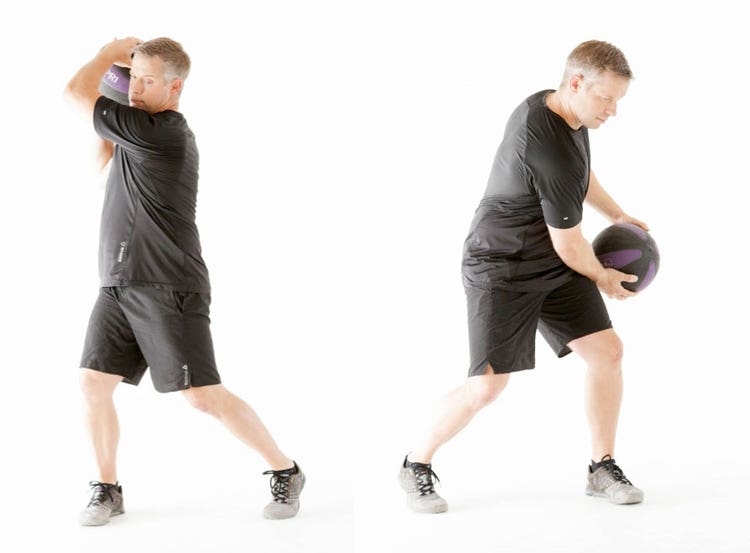
Medicine ball lift
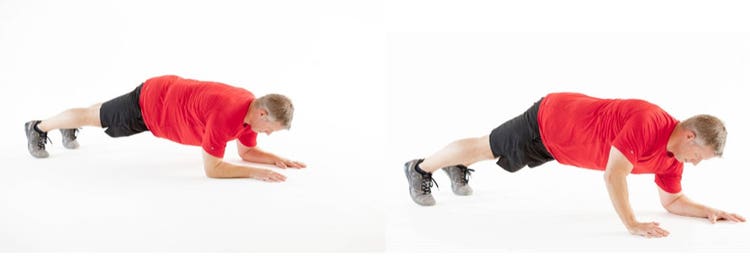
Plank-ups
2. Every minute on the minute (EMOM)
EMOMs are a relatively new way to organize a workout. After a complete warm-up, set a time. At the start of every minute do a certain number of reps of a movement. Once you are finished you have the rest of the minute to rest. EMOMs can either focus on only one movement, like kettlebell swings, or can alternate between upper and lower body movements like reverse lunges on the even minutes and renegade row push-ups on the odd minutes. For example, if it takes you 12 seconds to do 10 push-ups you will have 48 seconds to rest before the next exercise.
EMOMs are an effective way to focus on one or two movements and do a lot of work in a short amount of time, making them the perfect workout option for when your schedule gets busy and you have only a limited amount of time to hit the gym.
One-movement EMOM:
- Kettlebell swing: Set a timer for 12 minutes. At every minute complete 20 swings then rest for the remainder of the minute. This will help you knock out 240 reps in a short period of time. You’re welcome!
Two-movement EMOM:
- Even minutes: 10 reverse lunges (five each leg, hold a kettlebell or dumbbell in the opposite hand to improve core strength).
- Odd minutes: Renegade row push-ups (five reps each side, set a timer for 12 minutes and have fun).
If successful you’ll complete six sets of each movement, which is a lot of work in a short amount of time.
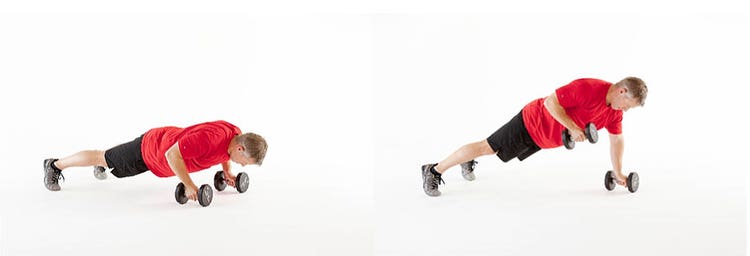
Renegade row push-ups
3. As many reps as possible (AMRAP)
In this context, AMRAP means performing as many reps of a movement as possible in a given period of time, making it an extremely effective and challenging way to organize a workout. Pushing yourself to complete as many reps as possible can provide the stimulus for muscle growth while expending calories for weight loss.
One method of ARMAP is to do a 30/30, which means set a timer for 60 seconds. For the first 30, do as many reps as possible of a movement, then rest for the remaining 30 seconds. Count the number of reps you do, then for each following set try to meet or beat the number you hit in the first set. Pushing yourself to work for time, as opposed to a set number of reps, can be an effective way to blast through a plateau.
AMRAP workout:
Thirty seconds of work followed by 30 seconds of rest; complete three to five sets of an exercise before moving to the next.
- TRX push-up
- Kettlebell goblet squat
- Dumbbell bent-over row
- Dumbbell hip press
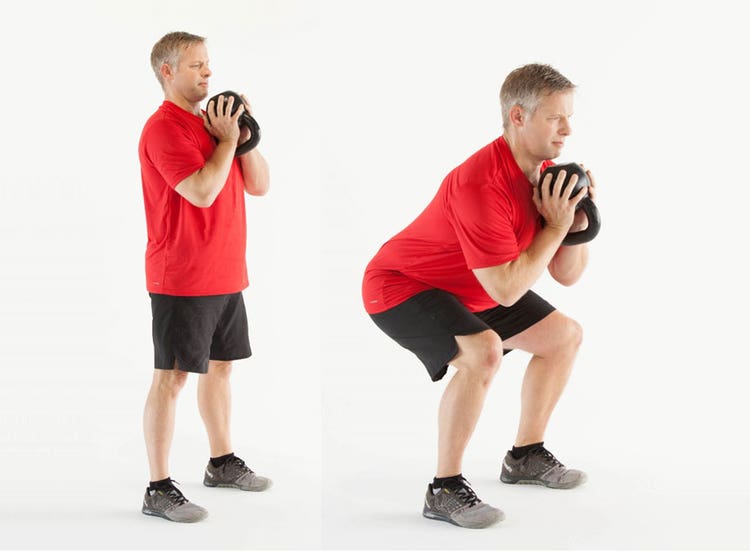
Kettlebell goblet squat
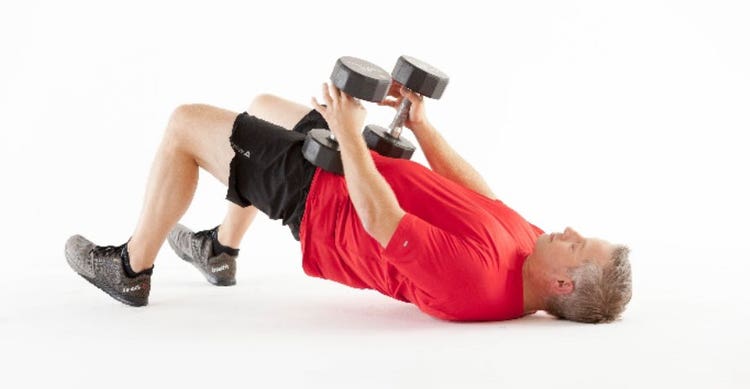
Dumbbell hip press
4. Russian 5×5 method
Even though Russia has been in the news a lot lately, it’s important to remember that politics aside, the former Soviet Union produced some of the best sport scientists in the world. In the ‘60s and ‘70s, while most professional athletes in the U.S. weren’t even lifting weight (the thought was it would make them slower), Soviet scientists were studying how to use strength training to improve human performance. One effective method they identified for improving total body strength is to do five sets of five reps for five different movements.
Five reps creates enough of an overload to increase muscular strength by improving the efficiency at which motor units contract, and increasing the thickness of individual muscle fibers—technically known as myofibrillar hypertrophy. Myofibrillar hypertrophy can help improve strength without necessarily increasing muscle size. A phase of 5×5 training will help develop a great base of strength for improving overall muscle size.
Select a weight for each movement that will be challenging but that allows you to complete five reps. (You should NOT be able to do a sixth rep.) To save time, use the circuit format, moving from one movement to the next with minimal rest. Allow one to two minutes of rest at the end of the circuit. If you’re “horizontal loading” (doing all five sets of a movement before going to the next movement), rest 60 seconds between sets.
Sample Russian 5×5 workout:
- Barbell deadlift
- Dumbbell chest press
- Barbell bent-over row
- Bulgarian split squat
- Dumbbell one-arm shoulder press
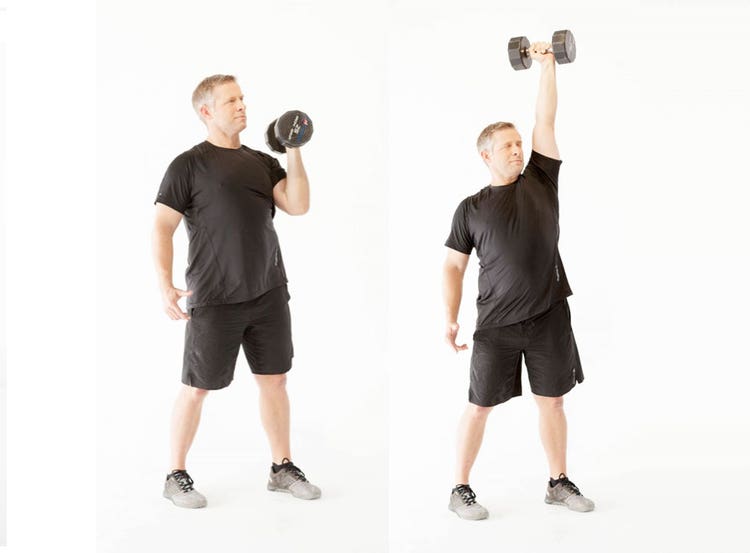
Dumbbell one-arm shoulder press
5. High-volume training
Hypertrophy, the technical term for muscle growth, is the result of a high volume of movement that creates both mechanical and metabolic overload of the involved muscle tissue.
Mechanical overload refers to the structural damage of a muscle fiber, which is then repaired by proteins, resulting in a thicker muscle fiber. Metabolic overload refers to depleting a muscle of available carbohydrate (stored as glycogen). As glycogen is constantly depleted the muscle will store more, leading to an increase in overall size. (Glycogen holds on to water, which is why it is so important to stay hydrated during a hypertrophy phase.)
An effective, proven way of organizing sets for high-volume work is the German high-volume method, which calls for doing 10 sets of 10 reps for up to two movements. This is perfect for super-setting two competing movements in a workout, like Romanian dead lift and goblet squats; or alternating between two upper-body moves such as chest presses and rows.
Sample workout:
For best results, select a weight for each movement that makes the last rep REALLY hard. If you can do more than 10, add weight.
- Dumbbell bent-over rows
- Kettlebell goblet squat
Rest approximately 60 seconds after completing both movements. Even if you can’t complete all 10 reps, work to complete all 10 sets. Once you can successfully complete 10 sets of 10 reps of a given weight, it will be time to increase the amount of weight used.

Dumbbell bent-over row
6. Complex sets
A complex set is a series of movements, usually three but sometimes four, all done in a row with little to no rest between each set, creating both the mechanical and metabolic overload necessary for growth. The idea of a complex set is to start with a compound, multi-joint movement before moving to single joint or isolation movements for a specific muscle. The goal of a complex set is to completely fatigue a particular muscle or muscle group which can be one of the best ways to create definition.
Upper-body complex to improve shoulder definition:
- Push-up to rotation (six reps on each arm)
- Dumbbell one-arm shoulder presses: Pick a weight that makes 10 to 12 reps on each arm challenging, then go immediately to:
- Standing rear delt raises: Select a weight that makes 10 to 12 reps on each arm difficult. No rest between switching arms.
After all movements, rest for two minutes. Complete three to four complexes.
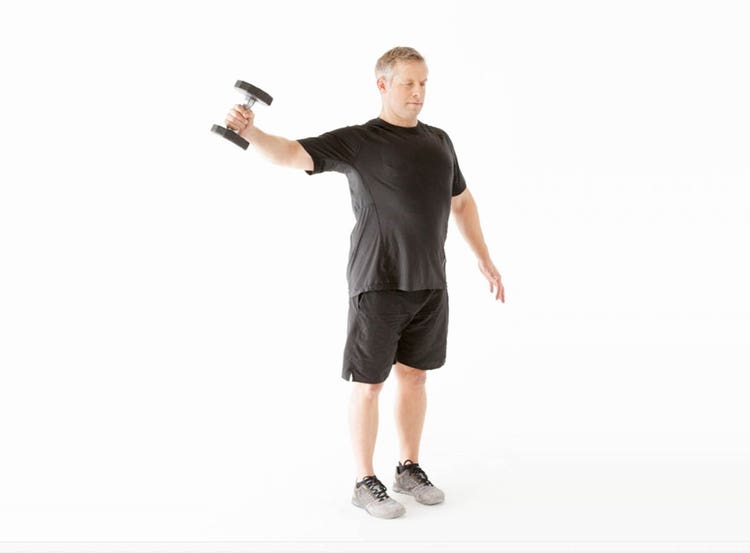
Standing rear delt raises
Exercise is a function of movement, and movement is a skill that must be developed with practice. Although changing up your workout will challenge your body, it’s important to maintain consistency with the movements you do, because repetition is essential for your body to learn how to move more effectively and make the changes you want.
For best results from your time in the gym, follow one specific method for a period of eight to 10 weeks before switching to a new method. We provided six different methods of organizing sets. If you follow each method for two months at a time, you will be doing a constantly changing exercise program that will challenge you in different ways throughout the entire year. Enjoy!
Photo credit: djiledesign, Thinkstock; Tom Casey/Box 24 Studio, box24studio.com